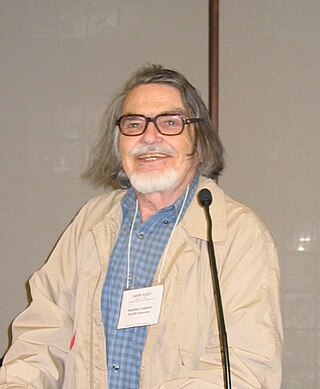Related Research Articles
In mathematics, a Hopf algebra, named after Heinz Hopf, is a structure that is simultaneously an algebra and a coalgebra, with these structures' compatibility making it a bialgebra, and that moreover is equipped with an antihomomorphism satisfying a certain property. The representation theory of a Hopf algebra is particularly nice, since the existence of compatible comultiplication, counit, and antipode allows for the construction of tensor products of representations, trivial representations, and dual representations.
In mathematics, the Séminaire de Géométrie Algébrique du Bois Marie was an influential seminar run by French mathematician Alexander Grothendieck. It was a unique phenomenon of research and publication outside of the main mathematical journals that ran from 1960 to 1969 at the Institut des Hautes Études Scientifiques (IHÉS) near Paris. The seminar notes were eventually published in twelve volumes, all except one in the Springer Lecture Notes in Mathematics series.
In programming language theory, semantics is the rigorous mathematical study of the meaning of programming languages. Semantics assigns computational meaning to valid strings in a programming language syntax. It is closely related to, and often crosses over with, the semantics of mathematical proofs.

Nobuo Yoneda was a Japanese mathematician and computer scientist.
Categorical logic is the branch of mathematics in which tools and concepts from category theory are applied to the study of mathematical logic. It is also notable for its connections to theoretical computer science. In broad terms, categorical logic represents both syntax and semantics by a category, and an interpretation by a functor. The categorical framework provides a rich conceptual background for logical and type-theoretic constructions. The subject has been recognisable in these terms since around 1970.

Joachim "Jim" Lambek was a Canadian mathematician. He was Peter Redpath Emeritus Professor of Pure Mathematics at McGill University, where he earned his PhD degree in 1950 with Hans Zassenhaus as advisor.

Yuri Ivanovich Manin was a Russian mathematician, known for work in algebraic geometry and diophantine geometry, and many expository works ranging from mathematical logic to theoretical physics.
In category theory, a branch of mathematics, Beck's monadicity theorem gives a criterion that characterises monadic functors, introduced by Jonathan Mock Beck in about 1964. It is often stated in dual form for comonads. It is sometimes called the Beck tripleability theorem because of the older term triple for a monad.
A bigraph can be modelled as the superposition of a graph and a set of trees.

Peter Henry George Aczel was a British mathematician, logician and Emeritus joint Professor in the Department of Computer Science and the School of Mathematics at the University of Manchester. He is known for his work in non-well-founded set theory, constructive set theory, and Frege structures.
Group-based cryptography is a use of groups to construct cryptographic primitives. A group is a very general algebraic object and most cryptographic schemes use groups in some way. In particular Diffie–Hellman key exchange uses finite cyclic groups. So the term group-based cryptography refers mostly to cryptographic protocols that use infinite non-abelian groups such as a braid group.

Roland Carl Backhouse is a British computer scientist and mathematician. As of 2020, he is Emeritus Professor of Computing Science at the University of Nottingham.
In the mathematical discipline of category theory, the Freyd cover or scone category is a construction that yields a set-like construction out of a given category. The only requirement is that the original category has a terminal object. The scone category inherits almost any categorical construct the original category has. Scones can be used to generally describe proofs that use logical relations.
In mathematics, a Zinbiel algebra or dual Leibniz algebra is a module over a commutative ring with a bilinear product satisfying the defining identity:
Jean-Louis Loday was a French mathematician who worked on cyclic homology and who introduced Leibniz algebras and Zinbiel algebras. He occasionally used the pseudonym Guillaume William Zinbiel, formed by reversing the last name of Gottfried Wilhelm Leibniz.
In the field of type theory in computer science, a quotient type is a data type which respects a user-defined equality relation. A quotient type defines an equivalence relation on elements of the type - for example, we might say that two values of the type Person are equivalent if they have the same name; formally p1 == p2 if p1.name == p2.name. In type theories which allow quotient types, an additional requirement is made that all operations must respect the equivalence between elements. For example, if f is a function on values of type Person, it must be the case that for two Persons p1 and p2, if p1 == p2 then f(p1) == f(p2).
Petra Mutzel is a German computer scientist, a University Professor of computer science at the University of Bonn. Her research is in the areas of algorithm engineering, graph drawing and combinatorial optimization.
Gunther Schmidt is a German mathematician who works also in informatics.
Martin Wirsing is a German computer scientist, and Professor at the Ludwig-Maximilians-Universität München, Germany.
Hartmut Ehrig was a German computer scientist and professor of theoretical computer science and formal specification. He was a pioneer in algebraic specification of abstract data types, and in graph grammars.
References
- ↑ Lambek, Joachim (1970). "Subequalizers". Canadian Mathematical Bulletin. 13 (3): 337–349. doi:10.4153/CMB-1970-065-6. MR 0274552.
- 1 2 Backhouse, Roland; Hoogendijk, Paul (1999). "Final dialgebras: from categories to allegories" (PDF). RAIRO Theoretical Informatics and Applications. 33 (4–5): 401–426. doi:10.1051/ita:1999126. MR 1748664.
- ↑ Hagino, Tatsuya (1987). "A typed lambda calculus with categorical type constructors". In Pitt, David H.; Poigné, Axel; Rydeheard, David E. (eds.). Category Theory and Computer Science, Edinburgh, UK, September 7–9, 1987, Proceedings. Lecture Notes in Computer Science. Vol. 283. Springer. pp. 140–157. doi:10.1007/3-540-18508-9_24. ISBN 978-3-540-18508-6.
- ↑ Poll, Erik; Zwanenburg, Jan (2001). "From algebras and coalgebras to dialgebras" (PDF). In Corradini, Andrea; Lenisa, Marina; Montanari, Ugo (eds.). Coalgebraic Methods in Computer Science, CMCS 2001, a Satellite Event of ETAPS 2001, Genova, Italy, April 6–7, 2001. Electronic Notes in Theoretical Computer Science. Vol. 44 (1 ed.). Elsevier. pp. 289–307. doi:10.1016/S1571-0661(04)80915-0. hdl: 2066/19049 .
- ↑ Loday, Jean-Louis (2001). "Dialgebras". In Loday, Jean-Louis; Chapoton, Frédéric; Frabetti, Alessandra; Goichot, François (eds.). Dialgebras and Related Operads. Lecture Notes in Mathematics. Vol. 1763. Springer. pp. 7–66. doi:10.1007/3-540-45328-8_2. ISBN 3-540-42194-7. MR 1860994. Zbl 0999.17002.